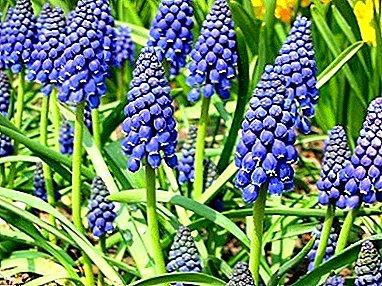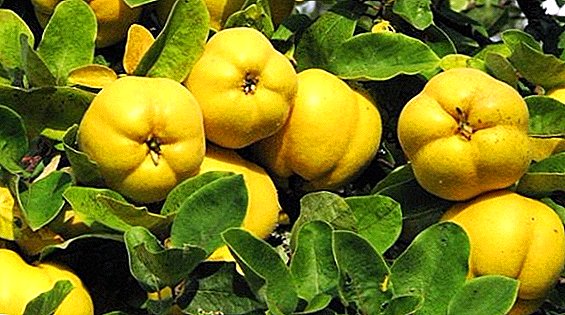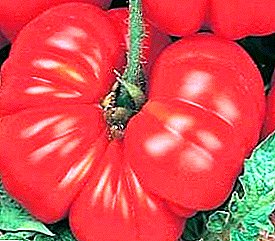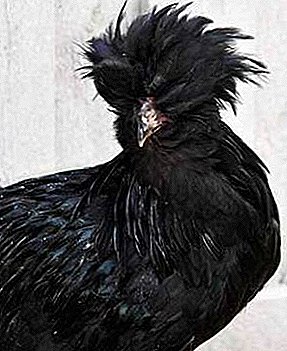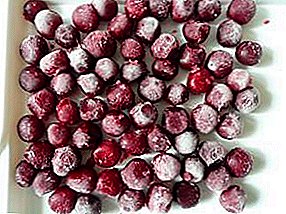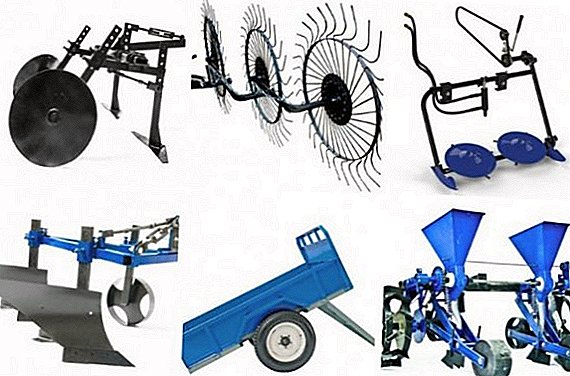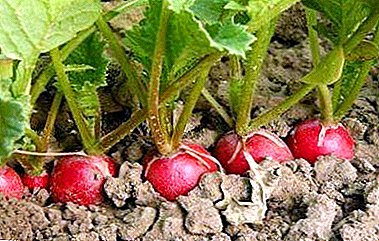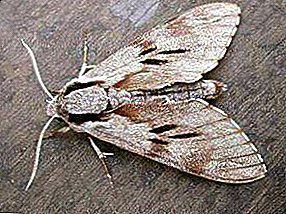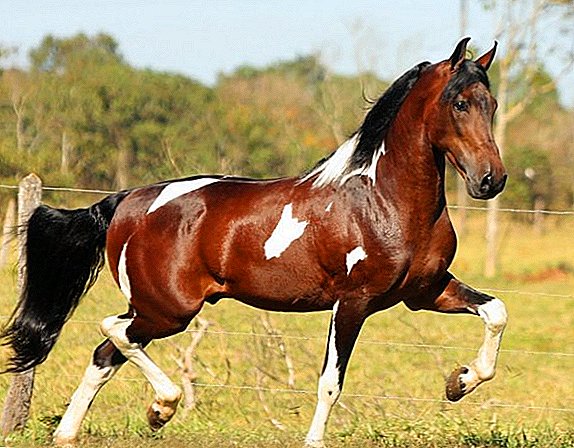 The term "gait" is probably familiar to people involved in equestrian sports, because their horses must not only walk calmly, but also run, and in completely different ways. The step, the lynx, the amble and the popular equestrian gallop are only the main types of movements of the animal, but it is not difficult to teach him other tricks of movement. Let's look at this issue more closely.
The term "gait" is probably familiar to people involved in equestrian sports, because their horses must not only walk calmly, but also run, and in completely different ways. The step, the lynx, the amble and the popular equestrian gallop are only the main types of movements of the animal, but it is not difficult to teach him other tricks of movement. Let's look at this issue more closely.
What is the glimpse
At each moment of time the horse under the rider performs many movements and the character of each of them is not similar to the previous one. The rider may need a lot of strength to make the animal move smoothly, or, conversely, to sharply overcome a certain obstacle, but in any case it will make a certain gait - the kind of movement around the area.
There are natural gaits (quiet step, trotting, gallop and amble), as well as artificial gaits, among which the most popular are Spanish lynx and step, passage, piaffe and some other types of "walking" horse.

Types of horse gaits
Any horse that has been trained or is beginning to train, to one degree or another, already possesses natural gables, and the rider can only bring the skill to perfection.
Step
This gait is deservedly considered the king of all gaits, because with it always begins the motor activity of the animal. In fact, it is a slow and unhurried kind of movement on the terrain, not particularly straining the muscles of the horse. The speed of movement in this case does not exceed 8 km / h.
Step - four-stroke gait, providing for the alternate presentation of the legs of the horse. Its sound is displayed as four separate hooves, but their tempo may differ, depending on how exactly the horse moves: short, medium or wide.
The difference between them is clearly visible and visually:
- with a short gait - traces from the hind legs are at a great distance from the marks of the front hoofs;
- with an average, the traces coincide;
- with a wide (added) - traces of the hind legs, the markings of the fore feet overshoot.
Important! Any training of the animal must begin and end with a free step, especially if its abilities are evaluated at this stage. The most flexible racers are those whose rear hooves stand in front of the front tracks approximately the size of one hoof.
Allure step: video
Lynx
In terms of speed, it is somewhat ahead of the pace, therefore it is considered the second gait. Many beginners in horseback riding call it the most difficult type, because the rider is already well aware of the tremors of the hooves and for comfortable movement you have to move in the saddle to the beat of the mount: on the first jerk you need to rise, and when you hit the second pair of hooves again fall into the saddle.
The lynx is a pace with two bars, because the horse's legs move in pairs, diagonally. Accordingly, having listened, you will hear only two blows to the ground, with a small interval.
There are several subspecies of trot:
- collected;
- average;
- working;
- added.
The lynx speed in experienced and trained trotters can reach 10 m / s. Representatives of Orlov, Russian, French and American trotters are considered the best in this business. They can trot long without fatigue.
Did you know? When racing on the racetrack, there are specialized names for horse races. For example, a slow trot is referred to as a "trot," and a fast trot is referred to as a "swing". In addition, you can hear about the "max" and "prize trot".
Allure trot: video
Gallop
This gait is much faster than the previous ones, and it is not for nothing that it is associated with real horse running. For novice riders, this method of movement may seem dangerous, but in fact, when properly placed in the saddle, all the tremors feel much easier than with the same trot.
The gallop provides for three bars: first, one horse’s back leg is taken out, then the second back leg and, at the same time, the front leg parallel to it. The latter is touched by the second foreleg, and the so-called “hang-up” phase begins. During the execution of all these actions, the rider hears three hooves clearly.
Learn how to transport horses.
Based on the speed of movement of the animal, there are several main types of canter:
- Manege (no more than three hundred meters per minute);
- leisurely or collected (more than two hundred meters per minute);
- average (400-700 m / min);
- spanning (800 m per minute);
- career (very fast run at a speed of 1000 meters per minute).
Allure canter: video
Amble
Relatively rare gait, which is not inherent in all horses. This is a kind of running of an animal, in which it rearranges its legs a little differently from a normal trot: first two legs move forward on the right side, and then two legs move left.
During such a run, the rider in the saddle shakes a little, but this does not cause any inconvenience. In the process of movement of the pacers, two hooves are clearly audible.
Find out what is remarkable about horse breeds: Soviet heavy truck, Trakenen, Frisian, Andalusian, Karachai, Falabella, Bashkir, Appaloosa, Tinker.
The amble is not a natural gait for all horses. It is often found in riding horses of the Crimea, the Caucasus and the Tien Shan Island, although it is no less characteristic of American trotters. In some cases it is an innate ability, in others the animal has to be trained in such a skill, and then the amble is considered an artificial pace.
Allure amble: video
Artificial gaits
Artificial gaits of horses have to be specially trained, since neither the passage, nor piaffe, nor other methods of movement are usually characteristic of horses from birth. True, it should be noted that some methods of artificial movement can still be congenital. This is due to the centuries-old tradition of riding demonstration.
Passage
This gait can be compared to a very quiet trot, with a slight movement of the legs forward. From the side, such a movement looks organically and beautifully, let the rider jump up a little (the horse’s hind legs are strongly under the body, and then playfully push off from the surface). In order to perform the movement perfectly, all the muscles of the back should work well in a horse, which largely depends on the structure of the horse.
Did you know? On average, the cost of a Russian horse prepared for competition is about 250-350 thousand rubles, although at the global level this figure often exceeds the million mark, and not in rubles, but in euros.
Allure passage: video
Piaffe
It is also called "the passage in one place." Performing this gait, the horse goes high trot, without moving forward. It is distinguished from the classic passageway by a greater leading of the hind legs under the torso and a long stage of suspension. At the same time, the horse's croup is slightly lowered, the hind limbs are bent, and the back vibrates.
Check out the best horse suits.
There are two subspecies of piaffe:
- slower (raising the legs is more expressive, and the pace as short as possible);
- fast (in this case, the horse is prepared to perform the classic piaffe, making it good to keep balance and reduce the pace of movement).
Allure piaffe: video
Spanish step
This gait is considered the main element of the highest category of riding. Its essence lies in the alternate elevation of a horse straightened in the putov and carpal joint of the forelegs (almost to the horizontal position). The return of the limbs to the place should be performed as smoothly as possible, and the hind legs at this moment move in the usual step.
Today, you can see the Spanish pitch mainly in circuses, since it is almost not included in sports programs.
Important! You can learn the classic Spanish pitch by the characteristic sound produced: with a high-quality performance, it is almost inaudible.
Allure Spanish step: video
Spanish lynx
The horse goes almost the same way as with the Spanish step, but all movements are performed at a trot: the horse carries the front leg forward, pulling it out parallel to the surface of the ground.
Get acquainted with riding breeds of horses.
Gallop on three legs and back
In the process of gallop on three legs, one of the horse's forelimbs must be straight and not touch the ground. Of course, because of the uncomfortable position of the body, such a gait is very difficult for an animal and not all riders practice it. If the leg is not extended or lowered enough, the execution of the gait will not be counted.
As for the gallop back, this is the complete opposite of the standard forward gallop, so all movements are performed in the reverse order. This type of move today is increasingly considered a circus, and not every horse can be taught a trick.
Gallop on three legs: video Of course, with home maintenance of horses, learning the gaits does not matter much, but if you breed purebred horses, who often take part in competitions and exhibitions, then in addition to natural gables you just need to teach them some artificial movements. How difficult it will be to take your lessons depends largely on both your diligence and the knight's ability to learn.


